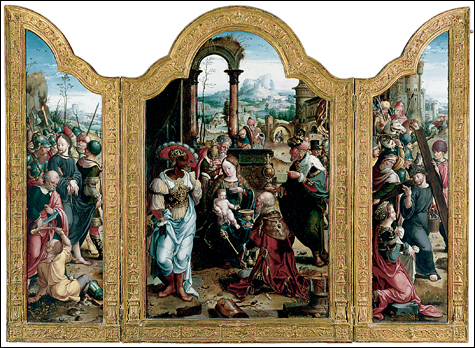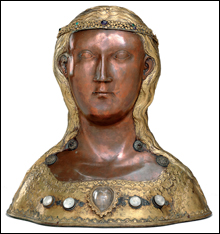
BIBLE STUDY Pieter Coecke van Aeist's "Christ Arrested in the Garden of Gethsemane, The Adoration of the Magi, Christ Carrying the Cross." |
Medieval artists got so much wrong. They often didn't know how to paint buildings in accurate perspective, or what lions actually looked like. And they were always painting castles and lions. But it's a wrongness that ends up being vigorously right — much like the best contemporary folk and so-called outsider art. They stumble into the sort of mistakes that make their art more raw and rivetingly weird and human.
And that's what energizes the jewelbox exhibit "Gothic Art In the Gilded Age: Medieval and Renaissance Treasures from the Gavet-Vanderbilt-Ringling Collection," at Marble House (596 Bellevue Avenue, Newport, through October 31). For the first time since 1927, the show returns the collection that Newport suffragette and society lady Alva Vanderbilt bought from Paris dealer Emile Gavet around 1889 to decorate the lavish summer palace — styled like a French Beaux Arts confection with 500,000 cubic feet of marble — that Richard Morris Hunt was building her in Newport.
Around the time it opened in 1892, Vanderbilt had more than 300 medieval and Renaissance paintings, sculptures, metalwork, furniture, and ceramics, mainly dating from the 13th to 16th centuries, installed in a room meant to evoke gothic France with oak paneling, arched stained-glass windows, red velvet wallpaper, and a ceiling ribbed like a cathedral.

SACRED RELIC "Reliquary Bust In the Form of a Young Woman." |
Most of Vanderbilt's collection is here, arranged just as she had it, as determined by period photos, plus a few replacement artworks filling in for missing pieces, some of which now reside at New York's Metropolitan Museum of Art. The effect is akin to Isabella Stewart Gardner's museum in Boston (also bought from Gavet), which opened in 1903. The number 300 somewhat exaggerates the scale of the show — it's in one good-sized room, and many of the works are small watches, rings, scarabs, and miniature wax medallion portraits of strange gray little popes and other dignitaries.The standout art is the paintings, and particularly the sculptures. Compare the realistic painted stucco Virgin and Child from about 1450, based on a design by Lorenzo Ghiberti, to the Virgin and Child As Seat of Wisdom, a simple late 12th-century Romanesque French limestone carving of Mary with baby Jesus seated upon her lap. The later Virgin is all tender, delicate motherhood. The earlier Mary is a dead-eyed woman in a gown that becomes a web of stylized folds. It's as if she foresees all the pain ahead, and her body has been eroded away by tears.
The Virgin Fainting At the Deposition is an astonishingly realized crowd of 10 little painted oak figures believed to be made in the Netherlands in the 1530s. After witnessing her son Jesus's crucifixion, Mary faints at the foot of the cross. A man and woman help her up, amidst the bustling crowd, and a pair of men hang off ladders leaning against an apparently lost cross. Each character is individualized with an exquisite, strange delicacy so the sum produces an uncanny charge.